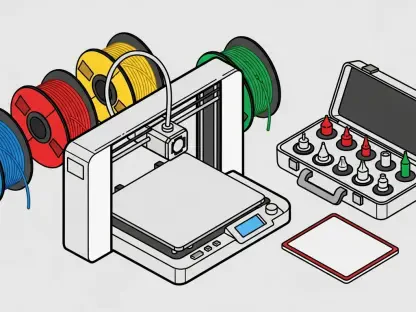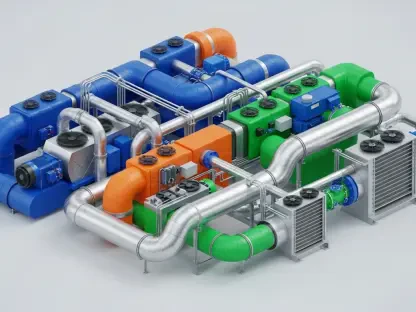The Current State of Network Monitoring in Manufacturing
Imagine a sprawling manufacturing plant where a single network glitch can halt production lines, costing thousands of dollars per minute in downtime, a scenario all too common in an industry heavily reliant on interconnected systems yet still tethered to outdated, reactive monitoring practices. Across the manufacturing sector, network monitoring remains predominantly alarm-based, with systems alerting administrators only after an issue has already disrupted operations. This reactive stance leaves little room for prevention, exposing facilities to significant risks in an era of digital transformation.
The importance of robust network monitoring cannot be overstated as manufacturing embraces increased connectivity through the integration of Information Technology (IT) and Operational Technology (OT). These systems ensure operational continuity by managing critical data flows and maintaining production efficiency. Beyond functionality, monitoring plays a pivotal role in security, safeguarding against cyber threats that exploit vulnerabilities in connected environments. As plants adopt smart technologies, the need for reliable oversight intensifies to protect both machinery and sensitive information.
While digital advancements promise efficiency, they also amplify the stakes of network failures. Many organizations struggle to keep pace with the evolving landscape, often relying on legacy tools ill-suited for modern demands. This gap between capability and necessity underscores a pressing challenge: how to transform monitoring from a reactive burden into a strategic asset that supports uninterrupted operations and fortified defenses.
Challenges and Trends in Network Management
Reactive Practices and Emerging Vulnerabilities
A staggering reality persists in manufacturing network management, where most organizations operate in a reactive mode. Recent surveys indicate that nearly two-thirds of companies depend on alarm-based alerts, addressing issues only after they surface. This delayed response often results in extended downtime and compromised systems, as there is little opportunity to mitigate risks before they escalate into full-blown crises.
The convergence of IT and OT systems introduces additional layers of vulnerability, compounding the problem. Legacy machinery, originally designed for isolated environments, now connects to broader networks without adequate security features like encryption or authentication. Outdated protocols further weaken defenses, while silos between IT and OT teams create blind spots that hinder comprehensive oversight, leaving systems exposed to potential breaches.
Compounding these technical shortcomings is the loss of institutional knowledge as experienced personnel retire. This gap in expertise makes it difficult to maintain or update aging infrastructure, increasing the likelihood of oversight failures. As digital integration deepens, these vulnerabilities highlight the urgent need for a shift in approach to address risks at their root rather than merely reacting to their consequences.
Cybersecurity Threats and Financial Impact
Cybersecurity threats have surged in manufacturing, with ransomware attacks showing a dramatic increase of nearly 50% quarter-over-quarter. Hackers exploit the IT-OT divide, targeting gaps where high downtime costs—often exceeding $10,000 per hour—pressure companies into compliance with ransom demands. This predatory focus on operational disruption poses a severe threat to industry stability.
The financial toll of unexpected downtime is equally alarming, with global losses for leading companies estimated at $1.5 trillion annually. Such figures emphasize the critical need for proactive solutions to prevent interruptions that erode profitability. Beyond immediate costs, breaches can damage long-term trust and competitiveness, amplifying the urgency for robust monitoring systems.
These escalating threats and economic impacts signal a turning point for the sector. Manufacturing entities must recognize that reactive measures are no longer sufficient against sophisticated adversaries. Investing in strategies to anticipate and neutralize risks before they materialize is not just a safeguard but a financial imperative to protect both operations and bottom lines.
Barriers to Proactive Network Monitoring
Transitioning to proactive network monitoring faces significant hurdles within manufacturing environments. Cultural disconnects between IT and OT teams stand as a primary obstacle, with differing priorities—data security for IT and production uptime for OT—creating fragmented approaches. This lack of alignment often results in incomplete visibility across systems, hampering efforts to preempt issues.
Technological limitations further complicate the shift, as many facilities rely on legacy infrastructure incompatible with modern predictive tools. The loss of expertise due to retiring veterans exacerbates this challenge, leaving gaps in understanding how to integrate or maintain complex systems. Without skilled personnel, organizations struggle to adopt advanced solutions that could transform their monitoring capabilities.
Overcoming these barriers requires deliberate strategies, such as fostering collaboration through joint training initiatives to bridge knowledge divides between teams. Upgrading outdated systems with scalable, secure technologies also offers a pathway forward. By addressing both human and technical constraints, manufacturing can lay the groundwork for predictive monitoring that anticipates disruptions rather than merely responding to them.
Regulatory and Security Considerations
Navigating the regulatory landscape is a critical aspect of network monitoring in manufacturing. Compliance with standards for data security and operational safety, such as those mandated by industry bodies, demands rigorous oversight of connected systems. Failure to meet these requirements can result in penalties and reputational damage, adding pressure to enhance monitoring practices.
Security considerations are equally paramount, given the vulnerabilities inherent in integrated industrial environments. The lack of robust safeguards in many OT systems makes them prime targets for cyber intrusions. Embedding cybersecurity into monitoring frameworks is essential to detect and mitigate threats, ensuring that protective measures keep pace with evolving risks.
Balancing regulatory adherence with security needs calls for a unified approach. Integrating compliance checks into monitoring protocols can streamline adherence, while adopting advanced threat detection tools strengthens defenses. This dual focus not only meets legal obligations but also fortifies systems against attacks, creating a more resilient operational foundation.
The Future of Network Monitoring: Predictive and Intelligent Systems
Envisioning the future of network monitoring reveals a promising shift toward predictive and intelligent systems in manufacturing. These advanced setups leverage data analytics to identify potential issues before they escalate, enabling preemptive action that minimizes downtime. Such capabilities mark a significant departure from traditional alarm-based responses, offering a proactive edge.
Emerging technologies, including machine learning and real-time analytics, are key enablers of this transformation. Coupled with cross-team collaboration between IT and OT, these tools enhance visibility and response precision. Establishing dedicated OT networking teams with dual expertise further supports the development of resilient operations tailored to modern challenges.
Building a future-proof monitoring framework hinges on sustained investment in innovation and partnership. By prioritizing intelligent systems over reactive fixes, manufacturing can anticipate disruptions, optimize performance, and secure critical infrastructure. This forward-thinking approach positions the industry to thrive amid increasing complexity and interconnectedness.
Conclusion and Call to Action
Reflecting on the insights gathered, it becomes evident that manufacturing has long grappled with the limitations of reactive network monitoring, often at great cost to operations and security. The persistent vulnerabilities from IT-OT convergence and escalating cyber threats have exposed the fragility of outdated practices. Financial losses from downtime have underscored the dire consequences of inaction, painting a clear picture of an industry at a crossroads.
Looking ahead, actionable steps emerge as vital for progress. Fostering deeper collaboration between IT and OT teams stands out as a cornerstone for breaking down silos and enhancing system visibility. Investing in predictive tools and upgrading legacy infrastructure offers a practical means to stay ahead of potential disruptions. These strategies, combined with a commitment to cybersecurity integration, promise not only to reduce downtime but also to build a foundation for enduring operational success in an ever-evolving landscape.









